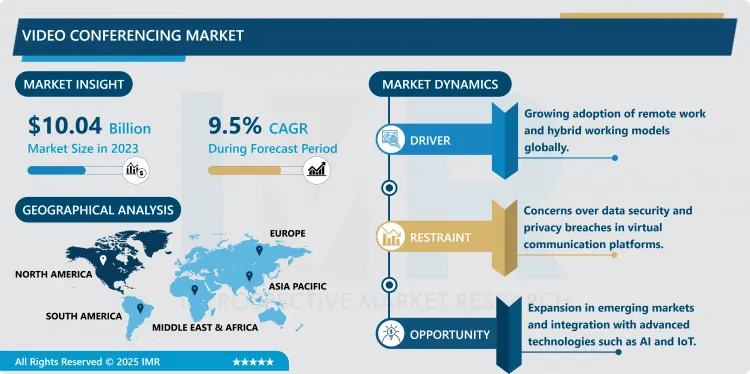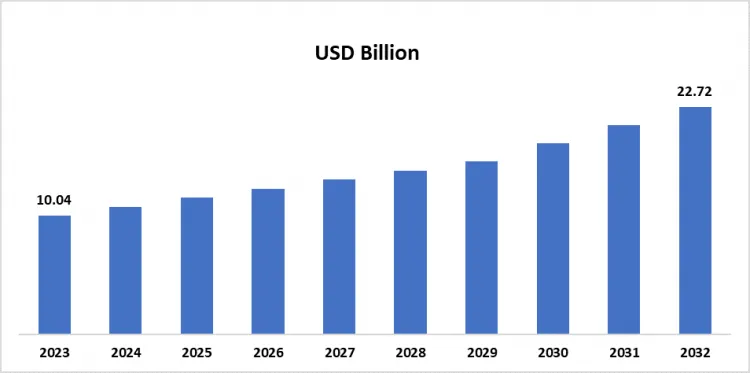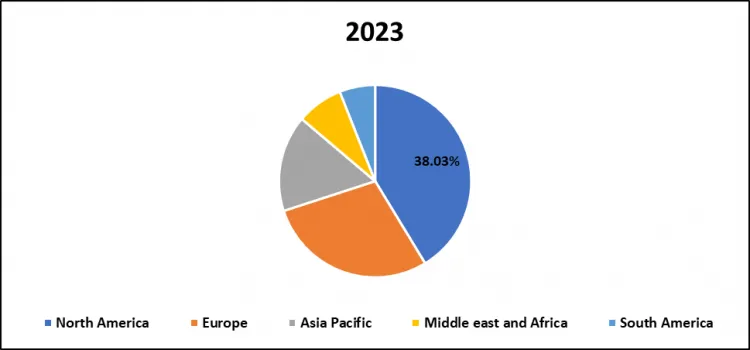Video Conferencing Market Synopsis
Video Conferencing Market Size Was Valued at USD 10.04 Billion in 2023, and is Projected to Reach USD 22.72 Billion by 2032, Growing at a CAGR of 9.5 % From 2024-2032.
The market in question pertains to the technologies and services through which users can interact with each other using real time videos irrespective of the geographical gap between them. This includes hardware; software; advisory, tele- and video-conferencing including place-providing solutions for people to attend meetings, seminars and work at a distance. Today video conferencing has become essential in the lives of all business persons, learners and health care givers and users and hence the following are some ways of enhancing interconnectivity, productivity and efficiency in communication.
Video conferencing has emerged as an active market in the last couple of years as most organizations adopt the global market with the need for effective means of communication. Businesses in all sectors are utilizing video conferencing in an attempt to reduce travelling time and costs, enhance teamwork, and calendar work from home. Because of modern tendencies of work in general and the emergence of hybrid and remote work methods, video conference plays an essential role in building team communication and work efficacy. Moreover, implementing new technologies has also raised the possibility and the indexes of the sort of feasible video conferencing solutions.
COVID-19 has elevated the usage and needs of video conferencing solutions from the category of luxury to that of necessity for businesses. Due to restrictions on contact in large numbers of people, Video Conference became the ultimate source of call for education online, doctor’s appointments, and business meetings. However, the interaction of these solutions is still high due to effectiveness and economic gains even though the pandemic is gradually fading off. Since its launch, it has undergone the process of optimization when markets rebuilt their focus on the number of users, reliability, and integration between numerous markets.

Video Conferencing Market Trend Analysis
AI-Powered Enhancements Revolutionizing Video Conferencing
- AI integration in the VC market is making the experience in-video-conferencing more intelligent. Some of the conceivable mainly AI integrated apps in when it comes to consider today are real time interpretation, automated captions, virtual background and noise removal. Such development go beyond the principles of greater accessibility, as well as recognizing diversity not only in how performing augmented virtual meeting, but also in terms of quality and effectiveness. AI-produced reports allow, inter alia, an assessment of the degree of involvement of meetings’ communication users, and one of the approaches that an organization can enhance is through the application of artificial intelligence analytics. Especially, the combination of AI system into the service will be another stiff trend since the world focuses on the quick and wise response.
Rising Demand in Education and Healthcare Sectors
- The different end-user industries and segment are especially favorable for the video consecrate market such as education and healthcare industries. In learning for instance, the growth of e-learning and virtual learning environment has persisted in demand for effective video conferencing solutions to provide for the functionality of an active learning space. Similarly, increased usage of telemedicine by health- care providers can be explained by the changes that make adoption of new technologies , such as the use of video conference for medical consultations , examination and follow up.
Video Conferencing Market Outlook, 2023 and 2032: Future Outlook

Video Conferencing Market Segment Analysis:
Video Conferencing Market Segmented on the basis of component, deployment and end user.
By Component, Hardware segment is expected to dominate the market during the forecast period
- Hardware segment is predicted to take the largest market share for the video conferencing market because it is charged with the task of establishing the communication bridges properly. Cameras and microphones, and display and dedicated conference equipment are needed to build up the environment mimicking a virtual meeting. Improved hardware hardware provides clearer audio and video areal, which is a must have when people are talking strictly in the business environment or across the distance.As more corporations and educational centers transition to a more work-and-learn-from-home model, demand for greater performance from PC hardware should follow. By the help of invoking modern technologies in hardware such as 4k cameras, AI tracking system inside and a refined internal sound system, this segment experienced its growth
By Deployment, the On-Premise segment expected to held the largest share
- The on-premise segment is forecasted to dominate the larger market share because of the organizations that prefer to dictate data security and management. More and more, organizations are turning to on-premise video conferencing because they can manage the video conferencing system and the related technology themselves. These solutions have especially been adopted in government, financial and health sectors as mentioned earlier because they are some of the most sensitive sectors that require compliance standards which defiantly require strong data security systems.
Video Conferencing Market Regional Insights:
North America is Expected to Dominate the Market Over the Forecast period
- North America will dominate the market for the video conferencing solutions during the forecasting period due to rising utilization of innovation in work models and presence of industry leaders in the region. Among all the countries, it has become tremendously prevalent for the United States to champion new significant video conferencing technologies suitable for business environments, learning institutions, and the health sector. The region is well developed and it has just reached the innovation stage which is ideal for market development.
- Speed at which enterprises in North America have adopted digital technologies and the appearance of a hybrid generation working model that incorporates offsite and on-site work has boosted video conferencing software. The existence of more regional bias can also be attributed to additional government sponsorship of digital structures along with more broadband Internet connections. In that area, competitiveness pressure is ever present because of the frequent new products and strategic collaboration by the primary stakeholders in North America, thus ensuring the continuous leadership of the company.

Active Key Players in the Video Conferencing Market
- Adobe Inc. (USA)
- Amazon Web Services (AWS) (USA)
- Avaya Inc. (USA)
- Cisco Systems, Inc. (USA)
- Google LLC (USA)
- Huawei Technologies Co., Ltd. (China)
- Logitech International S.A. (Switzerland)
- Microsoft Corporation (USA)
- Poly (Plantronics, Inc.) (USA)
- RingCentral, Inc. (USA)
- Slack Technologies (USA)
- Tencent Holdings Ltd. (China)
- Zoom Video Communications, Inc. (USA)
- Zoho Corporation (India)
- ZTE Corporation (China)
- Other key Players
|
Video Conferencing Market |
|||
|
Base Year: |
2023 |
Forecast Period: |
2024-2032 |
|
Historical Data: |
2017 to 2023 |
Market Size in 2023: |
USD 10.04 Billion |
|
Forecast Period 2024-32 CAGR: |
9.5 % |
Market Size in 2032: |
USD 22.72 Billion |
|
Segments Covered: |
By Component |
|
|
|
By Deployment |
|
||
|
By End User |
|
||
|
By Region |
|
||
|
Key Market Drivers: |
|
||
|
Key Market Restraints: |
|
||
|
Key Opportunities: |
|
||
|
Companies Covered in the report: |
|
||
Chapter 1: Introduction
1.1 Scope and Coverage
Chapter 2:Executive Summary
Chapter 3: Market Landscape
3.1 Market Dynamics
3.1.1 Drivers
3.1.2 Restraints
3.1.3 Opportunities
3.1.4 Challenges
3.2 Market Trend Analysis
3.3 PESTLE Analysis
3.4 Porter's Five Forces Analysis
3.5 Industry Value Chain Analysis
3.6 Ecosystem
3.7 Regulatory Landscape
3.8 Price Trend Analysis
3.9 Patent Analysis
3.10 Technology Evolution
3.11 Investment Pockets
3.12 Import-Export Analysis
Chapter 4: Video Conferencing Market by Product
4.1 Video Conferencing Market Snapshot and Growth Engine
4.2 Video Conferencing Market Overview
4.3 Powered Dental Scalers Handheld Dental Scalers Scaler Inserts
4.3.1 Introduction and Market Overview
4.3.2 Historic and Forecasted Market Size in Value USD and Volume Units (2017-2032F)
4.3.3 Key Market Trends, Growth Factors and Opportunities
4.3.4 Powered Dental Scalers Handheld Dental Scalers Scaler Inserts: Geographic Segmentation Analysis
Chapter 5: Video Conferencing Market by Application
5.1 Video Conferencing Market Snapshot and Growth Engine
5.2 Video Conferencing Market Overview
5.3 Periodontics Endodontic
5.3.1 Introduction and Market Overview
5.3.2 Historic and Forecasted Market Size in Value USD and Volume Units (2017-2032F)
5.3.3 Key Market Trends, Growth Factors and Opportunities
5.3.4 Periodontics Endodontic: Geographic Segmentation Analysis
Chapter 6: Video Conferencing Market by End User
6.1 Video Conferencing Market Snapshot and Growth Engine
6.2 Video Conferencing Market Overview
6.3 Hospitals Dental Clinics
6.3.1 Introduction and Market Overview
6.3.2 Historic and Forecasted Market Size in Value USD and Volume Units (2017-2032F)
6.3.3 Key Market Trends, Growth Factors and Opportunities
6.3.4 Hospitals Dental Clinics: Geographic Segmentation Analysis
Chapter 7: Company Profiles and Competitive Analysis
7.1 Competitive Landscape
7.1.1 Competitive Benchmarking
7.1.2 Video Conferencing Market Share by Manufacturer (2023)
7.1.3 Industry BCG Matrix
7.1.4 Heat Map Analysis
7.1.5 Mergers and Acquisitions
7.2 A-DEC INC. (USA)
7.2.1 Company Overview
7.2.2 Key Executives
7.2.3 Company Snapshot
7.2.4 Role of the Company in the Market
7.2.5 Sustainability and Social Responsibility
7.2.6 Operating Business Segments
7.2.7 Product Portfolio
7.2.8 Business Performance
7.2.9 Key Strategic Moves and Recent Developments
7.2.10 SWOT Analysis
7.3 DENTSPLY SIRONA (USA)
7.4 EMS ELECTRO MEDICAL SYSTEMS SA (SWITZERLAND)
7.5 HU-FRIEDY MFG CO. (USA)
7.6 IVOCLAR VIVADENT (LIECHTENSTEIN)
7.7 KAVO DENTAL (GERMANY)
7.8 MORITA CORPORATION (JAPAN)
7.9 NSK LTD. (JAPAN)
7.10 PLANMECA OY (FINLAND)
7.11 PRESTIGE DENTAL EQUIPMENT (USA)
7.12 SHARP ENGINEERING (INDIA)
7.13 SHINVA MEDICAL INSTRUMENT CO. LTD. (CHINA)
7.14 SIRONA DENTAL SYSTEMS INC. (GERMANY)
7.15 THOMMEN MEDICAL AG (SWITZERLAND)
7.16 WOODPECKER MEDICAL TECHNOLOGY CO. LTD. (CHINA)
7.17 OTHER ACTIVE PLAYERS
Chapter 8: Global Video Conferencing Market By Region
8.1 Overview
8.2. North America Video Conferencing Market
8.2.1 Key Market Trends, Growth Factors and Opportunities
8.2.2 Top Key Companies
8.2.3 Historic and Forecasted Market Size by Segments
8.2.4 Historic and Forecasted Market Size By Product
8.2.4.1 Powered Dental Scalers Handheld Dental Scalers Scaler Inserts
8.2.5 Historic and Forecasted Market Size By Application
8.2.5.1 Periodontics Endodontic
8.2.6 Historic and Forecasted Market Size By End User
8.2.6.1 Hospitals Dental Clinics
8.2.7 Historic and Forecast Market Size by Country
8.2.7.1 US
8.2.7.2 Canada
8.2.7.3 Mexico
8.3. Eastern Europe Video Conferencing Market
8.3.1 Key Market Trends, Growth Factors and Opportunities
8.3.2 Top Key Companies
8.3.3 Historic and Forecasted Market Size by Segments
8.3.4 Historic and Forecasted Market Size By Product
8.3.4.1 Powered Dental Scalers Handheld Dental Scalers Scaler Inserts
8.3.5 Historic and Forecasted Market Size By Application
8.3.5.1 Periodontics Endodontic
8.3.6 Historic and Forecasted Market Size By End User
8.3.6.1 Hospitals Dental Clinics
8.3.7 Historic and Forecast Market Size by Country
8.3.7.1 Russia
8.3.7.2 Bulgaria
8.3.7.3 The Czech Republic
8.3.7.4 Hungary
8.3.7.5 Poland
8.3.7.6 Romania
8.3.7.7 Rest of Eastern Europe
8.4. Western Europe Video Conferencing Market
8.4.1 Key Market Trends, Growth Factors and Opportunities
8.4.2 Top Key Companies
8.4.3 Historic and Forecasted Market Size by Segments
8.4.4 Historic and Forecasted Market Size By Product
8.4.4.1 Powered Dental Scalers Handheld Dental Scalers Scaler Inserts
8.4.5 Historic and Forecasted Market Size By Application
8.4.5.1 Periodontics Endodontic
8.4.6 Historic and Forecasted Market Size By End User
8.4.6.1 Hospitals Dental Clinics
8.4.7 Historic and Forecast Market Size by Country
8.4.7.1 Germany
8.4.7.2 UK
8.4.7.3 France
8.4.7.4 The Netherlands
8.4.7.5 Italy
8.4.7.6 Spain
8.4.7.7 Rest of Western Europe
8.5. Asia Pacific Video Conferencing Market
8.5.1 Key Market Trends, Growth Factors and Opportunities
8.5.2 Top Key Companies
8.5.3 Historic and Forecasted Market Size by Segments
8.5.4 Historic and Forecasted Market Size By Product
8.5.4.1 Powered Dental Scalers Handheld Dental Scalers Scaler Inserts
8.5.5 Historic and Forecasted Market Size By Application
8.5.5.1 Periodontics Endodontic
8.5.6 Historic and Forecasted Market Size By End User
8.5.6.1 Hospitals Dental Clinics
8.5.7 Historic and Forecast Market Size by Country
8.5.7.1 China
8.5.7.2 India
8.5.7.3 Japan
8.5.7.4 South Korea
8.5.7.5 Malaysia
8.5.7.6 Thailand
8.5.7.7 Vietnam
8.5.7.8 The Philippines
8.5.7.9 Australia
8.5.7.10 New Zealand
8.5.7.11 Rest of APAC
8.6. Middle East & Africa Video Conferencing Market
8.6.1 Key Market Trends, Growth Factors and Opportunities
8.6.2 Top Key Companies
8.6.3 Historic and Forecasted Market Size by Segments
8.6.4 Historic and Forecasted Market Size By Product
8.6.4.1 Powered Dental Scalers Handheld Dental Scalers Scaler Inserts
8.6.5 Historic and Forecasted Market Size By Application
8.6.5.1 Periodontics Endodontic
8.6.6 Historic and Forecasted Market Size By End User
8.6.6.1 Hospitals Dental Clinics
8.6.7 Historic and Forecast Market Size by Country
8.6.7.1 Turkiye
8.6.7.2 Bahrain
8.6.7.3 Kuwait
8.6.7.4 Saudi Arabia
8.6.7.5 Qatar
8.6.7.6 UAE
8.6.7.7 Israel
8.6.7.8 South Africa
8.7. South America Video Conferencing Market
8.7.1 Key Market Trends, Growth Factors and Opportunities
8.7.2 Top Key Companies
8.7.3 Historic and Forecasted Market Size by Segments
8.7.4 Historic and Forecasted Market Size By Product
8.7.4.1 Powered Dental Scalers Handheld Dental Scalers Scaler Inserts
8.7.5 Historic and Forecasted Market Size By Application
8.7.5.1 Periodontics Endodontic
8.7.6 Historic and Forecasted Market Size By End User
8.7.6.1 Hospitals Dental Clinics
8.7.7 Historic and Forecast Market Size by Country
8.7.7.1 Brazil
8.7.7.2 Argentina
8.7.7.3 Rest of SA
Chapter 9 Analyst Viewpoint and Conclusion
9.1 Recommendations and Concluding Analysis
9.2 Potential Market Strategies
Chapter 10 Research Methodology
10.1 Research Process
10.2 Primary Research
10.3 Secondary Research
|
Video Conferencing Market |
|||
|
Base Year: |
2023 |
Forecast Period: |
2024-2032 |
|
Historical Data: |
2017 to 2023 |
Market Size in 2023: |
USD 10.04 Billion |
|
Forecast Period 2024-32 CAGR: |
9.5 % |
Market Size in 2032: |
USD 22.72 Billion |
|
Segments Covered: |
By Component |
|
|
|
By Deployment |
|
||
|
By End User |
|
||
|
By Region |
|
||
|
Key Market Drivers: |
|
||
|
Key Market Restraints: |
|
||
|
Key Opportunities: |
|
||
|
Companies Covered in the report: |
|
||
Frequently Asked Questions :
The forecast period in the Video Conferencing Market research report is 2024-2032.
Cisco Systems, Google LLC, Microsoft Corporation, Zoom Video Communications, Tencent Holdings Ltd.
The Video Conferencing Market is segmented into Component, Deployment, End User and region. By Component, the market is categorized into Hardware Camera Microphone/Headphone Others Software Service Professional services Managed Service. By Deployment, the market is categorized into On-premise Cloud. By End User, the market is categorized into Corporate Education Healthcare Government & Defense BFSI Media & Entertainment Others. By region, it is analyzed across North America (U.S.; Canada; Mexico), Eastern Europe (Bulgaria; The Czech Republic; Hungary; Poland; Romania; Rest of Eastern Europe), Western Europe (Germany; UK; France; Netherlands; Italy; Russia; Spain; Rest of Western Europe), Asia-Pacific (China; India; Japan; Southeast Asia, etc.), South America (Brazil; Argentina, etc.), Middle East & Africa (Saudi Arabia; South Africa, etc.).
The market in question pertains to the technologies and services through which users can interact with each other using real time videos irrespective of the geographical gap between them. This includes hardware; software; advisory, tele- and video-conferencing including place-providing solutions for people to attend meetings, seminars and work at a distance. Today video conferencing has become essential in the lives of all business persons, learners and health care givers and users and hence the following are some ways of enhancing interconnectivity, productivity and efficiency in communication.
Video Conferencing Market Size Was Valued at USD 10.04 Billion in 2023, and is Projected to Reach USD 22.72 Billion by 2032, Growing at a CAGR of 9.5 % From 2024-2032.












